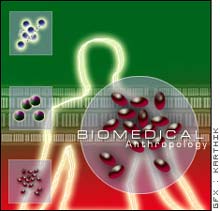
As SARS and other new diseases cross geographical boundaries with increasing rapidity, the need for Binghamton University’s new master of science in biomedical anthropology becomes ever more apparent.
The program, the first of its kind in the world, will offer a multi-disciplinary approach to the study of the transmission and spread of infections, cellular and molecular mechanisms of disease, and the interaction of biological and socio-cultural factors that shape health outcomes.
Th

Genes come in pairs, one copy from your mom and one from your dad. In some genetic conditions, inheriting one bad, or mutant, gene copy from either parent is sufficient to cause disease. University of Iowa researchers have shown that it is possible to silence a mutant gene without affecting expression of the normal gene.
The findings suggest that the gene-silencing technique might one day be useful in treating many human diseases, including cancer, Huntington’s disease and similar genetic

Men are from Mars and women are from Venus, or so we’ve been told, and when it comes to jealousy this is especially true. Men, psychologists have long contended, tend to care more about sexual infidelity while women usually react more strongly to emotional infidelity. This view has long been espoused by evolutionary psychologists who attribute these gender differences to natural selection, which, they say, encouraged the sexes to develop different emotional reactions to jealousy.
However, a

Human beings may have made their first journey out of Africa as recently as 70,000 years ago, according to a new study by geneticists from Stanford University and the Russian Academy of Sciences. Writing in the American Journal of Human Genetics, the researchers estimate that the entire population of ancestral humans at the time of the African expansion consisted of only about 2,000 individuals.
“This estimate does not preclude the presence of other populations of Homo sapiens sapiens [mode

If an asteroid crashes into the Earth, it is likely to splash down somewhere in the oceans that cover 70 percent of the planet’s surface. Huge tsunami waves, spreading out from the impact site like the ripples from a rock tossed into a pond, would inundate heavily populated coastal areas. A computer simulation of an asteroid impact tsunami developed by scientists at the University of California, Santa Cruz, shows waves as high as 400 feet sweeping onto the Atlantic Coast of the United States.

New features may make southern sky’s ’Coalsack’ ideal for further study
Stargazers call a prominent dark black region in the Southern Hemisphere’s night sky the Coalsack. Even for naked-eye observers, the cloud of cold gas that makes up the Coalsack is hard to miss: It covers a part of the misty luminescence of the Milky Way, blocking out distant stars of our galaxy with the deep black shades that have earned the Coalsack its name.
A newly discovered aspect of the C

– new calculation confirms standard model of particle physics. Contribution of hadronic vacuum polarization determined with unprecedented accuracy. The magnetic moment of the muon is an important precision parameter for…
Technique may prevent formation of unwanted waves that siphon off needed energy. Heating plasma to the ultra-high temperatures needed for fusion reactions requires more than turning the dial on a…

An international team of astronomers, led by researchers from the Astronomical Observatory of the University of Warsaw, have identified a new class of cosmic X-ray sources. The findings have been…

Antibody that Neutralizes Inhibitory Factors Involved in Nerve Regeneration Leads to Enhanced Motor Function after Acute Spinal Cord Injury. Researchers at 13 clinics in Germany, Switzerland, the Czech Republic and…

How the body’s natural killer cells could fight leukemia. Every year, some 13,000 people in Germany are diagnosed with leukemia. Despite intensive chemotherapy, around one in two of them die….

… eco-friendly reactor converts air and water into ammonia. Producing enough ammonia to feed the world comes with a large carbon footprint;. process described in new UB-led study could help…

How simulations help manufacturing of modern displays. Modern materials must be recyclable and sustainable. Consumer electronics is no exception, with organic light-emitting diodes (OLEDs) taking over modern televisions and portable…

“Neurons that fire together, wire together” describes the neural plasticity seen in human brains, but neurons grown in a dish don’t seem to follow these rules. Neurons that are cultured…

The quest for sustainable energy solutions has been a major focus of scientific research for decades. Solar energy, a clean and renewable source, has emerged as a promising alternative to…

With a processing speed a billion times faster than nature, chip-based laser neuron could help advance AI tasks such as pattern recognition and sequence prediction. Researchers have developed a laser-based…

New technology could remotely identify various types of plastics, offering a valuable tool for future monitoring and analysis of oceanic plastic pollution. Researchers have developed a new hyperspectral Raman imaging…

Artificial Intelligence (AI) has established a strong presence across industries, large and small. The “VoBaKI” research project has empowered small and medium-sized enterprises (SMEs) with an innovative tool to independently…